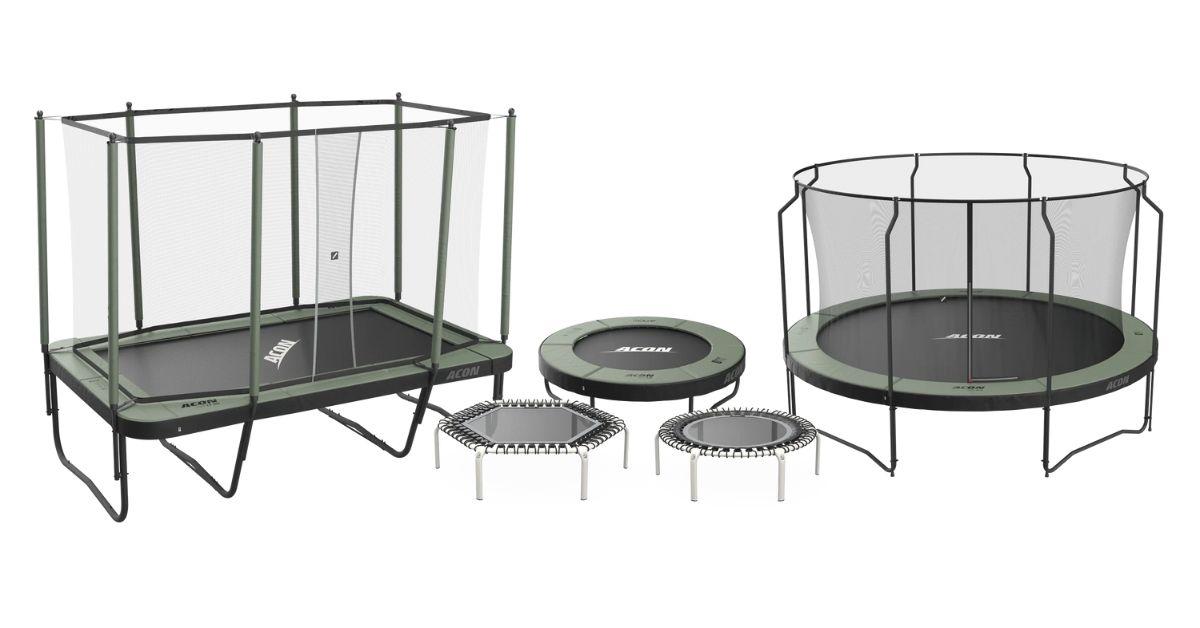Trampoline vs Rebounder – Key Differences Explained

Introduction to Bouncing Fitness and Fun
Trampolines and rebounders may look similar, but they serve very different purposes. Both involve bouncing, but one is designed for play, exercise, and acrobatics, while the other focuses on low-impact fitness routines. If you are trying to decide whether a trampoline or a rebounder is right for you, understanding their differences can help you choose wisely.
What is a Trampoline
A trampoline is a large, durable frame with a fabric mat stretched tightly by springs. It is typically installed in backyards, gyms, and recreational parks. Modern trampolines come in different shapes such as round, rectangular, and oval, each offering a unique bounce experience. Unlike rebounders, trampolines are designed for a mix of fun, sports training, and fitness.
What is a Rebounder
A rebounder, sometimes called a mini trampoline, is a smaller piece of equipment designed primarily for exercise. Its compact size makes it ideal for indoor workouts. Rebounders are often used for routines that involve controlled bouncing, jogging in place, and stability exercises. The main goal is improving cardiovascular health and reducing joint impact, rather than performing tricks or high jumps.
Size and Design Differences
One of the most noticeable differences between a trampoline and a rebounder is size. Trampolines are built to hold one or multiple people at once, often ranging between 8 to 16 feet in diameter or length. For example, a rectangular trampoline is popular among athletes and gymnasts because it offers powerful, consistent bounce across the entire surface.
In contrast, rebounders usually measure about 3 to 4 feet in diameter and are meant for individual use. They are portable, lightweight, and easy to store inside a home gym space.
Purpose and Functionality
The purpose of trampolines extends beyond fitness. They provide entertainment for children, help athletes practice acrobatics, and can even be used in competitive sports. Families often choose oval trampolines because they combine fun with versatile space for multiple jumpers.
Rebounders, however, are specifically built for fitness training. They support exercises that improve balance, lymphatic circulation, and endurance while keeping movements low-impact and safe for joints.
Safety Considerations
Trampolines, especially larger ones, require safety measures such as enclosure nets and padding. Their size and height make it possible to perform flips and higher jumps, which can be risky without proper precautions.
Rebounders, being smaller and closer to the ground, have fewer safety concerns. They do not require nets and are easier to control during exercise. However, both types of equipment should be used with care and correct form.
Health and Fitness Benefits
Both trampolines and rebounders improve cardiovascular health and muscle tone, but they deliver results in different ways.
-
Trampolines encourage aerobic exercise, flexibility, and coordination. They also help children and adults stay active while having fun.
-
Rebounders target lymphatic drainage, joint health, and core strength. They are often recommended for people who want a gentle yet effective workout.
Indoor vs Outdoor Use
Trampolines are designed mostly for outdoor use due to their large size, though some smaller models can fit inside gyms. Rebounders are almost always used indoors, making them more accessible for year-round workouts.
Cost and Durability
Trampolines vary in price depending on size, shape, and material, often being a long-term investment for families. They require outdoor space and maintenance.
Rebounders are less expensive, easy to maintain, and last a long time with regular use. They are a good choice for individuals who want an affordable fitness tool.
Which One Should You Choose
Your choice depends on your goals. If you want family fun, outdoor activity, or sports training, a trampoline is the best fit. If your focus is personal fitness, joint health, or a compact exercise tool, a rebounder will serve you better.
Frequently Asked Questions
Is a rebounder the same as a trampoline?
No. A rebounder is a smaller version designed for fitness workouts, while trampolines are larger and built for play, training, or recreation.
Can children use a rebounder?
Yes, but rebounders are mainly designed for adults. Children should use trampolines for safe recreational play.
Which burns more calories, a trampoline or a rebounder?
Both can help burn calories, but rebounders are used for structured exercise routines that can deliver faster calorie-burning results.
Are trampolines safe for adults?
Yes. Many adults use trampolines for fitness or sports training, but safety accessories like nets and padding are highly recommended.
Can rebounders replace regular gym workouts?
Rebounders can complement gym workouts by offering cardio and low-impact training, but they may not replace strength training or high-intensity routines.
Conclusion
The difference between trampolines and rebounders lies in their size, purpose, and usage. A trampoline is perfect for outdoor fun, sports, and family activities, while a rebounder is ideal for compact indoor workouts with health-focused benefits. Both options promote active living, but the right choice depends on your lifestyle and fitness goals.
- Art
- Causes
- Crafts
- Dance
- Drinks
- Film
- Fitness
- Food
- Games
- Gardening
- Health
- Home
- Literature
- Music
- Networking
- Other
- Party
- Religion
- Shopping
- Sports
- Theater
- Wellness



